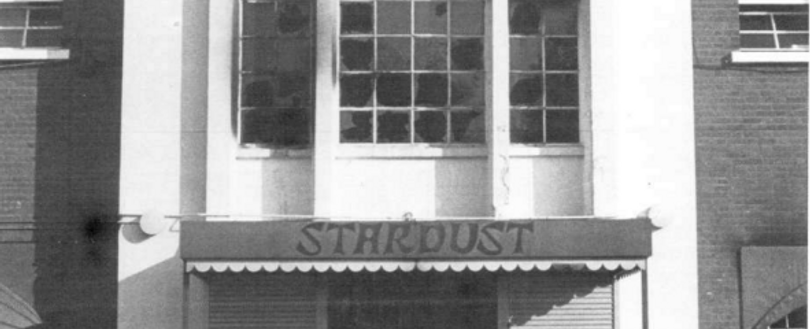- Homepage
- News
- Blogs & Articles
- On this day, forgotten disasters: The Stardust nightclub fire

On this day, forgotten disasters: The Stardust nightclub fire
Like it? Share it!
14 February 2024 by FIA Team, FIA Team
Our technical managers at the Fire Industry Association provide their insights into this horrific event, emphasising the indispensable importance of fire safety protocols and regulations governing public spaces.
St Valentine’s day of 1981 at The Stardust nightclub in Artane, Dublin. An evening where the atmosphere was one of excitement as patrons gathered to celebrate love and camaraderie. However, the joyous occasion took a tragic turn and became the scene of a devastating fire, claiming the lives of 48 people and leaving 214 others injured. Of the 214 injuries, 128 required inpatient hospital treatment, with 86 treated as outpatients. This incident cast a dark shadow on the lives of those present, their families and the wider nation. The impact of the tragedy surpassed the initial loss, as not only survivors, but family members also, battled with the deep weight of sorrow, and in certain cases being confronted by the persistent psychological challenges, lead to further tragic consequences, with suicides being attributed to the event.
Originally a food factory, the building in which the The Stardust nightclub was located underwent a conversion in 1978 to become a multi purpose amenity centre, consisting of a bar (The Silver Swan), a function room (The Lantern Rooms), and The Stardust nightclub.
The Stardust venue, complete with a dance floor, stage and 2 seating areas – the North and West alcoves, was the setting for the evening Valentine’s disco event. Around 1:30am many patrons noticed what they perceived to be a fire from the West Alcove seating area. The fire swiftly spread to other seats within the vicinity, and within three to four minutes flames reached the ceiling itself, with portions of the ceiling collapsing and thick black smoke consuming the alcove.
The Fire soon engulfed the entire building, with the presence of thick black smoke and toxic gasses throughout. This, combined with numerous obstacles presented by tables and chairs, and emergency exits being either blocked or locked, and windows secured with bars, heightened the struggles of those trying to escape. The failure of the emergency/secondary lighting system also intensified the state of confusion, inducing further widespread panic.
The first telephone call to the Fire and Rescue Service was made at 1:43am, and in spite of a swift reaction from all emergency services, they faced an inferno on a scale that led many to question their level of preparedness for an emergency of such high intensity.
Of the 48 fatalities, their ages ranged from 16-28, with the average age being documented as 19.5 years old, an unfathomable loss of life among people so young.
The aftermath of The Stardust nightclub fire was nothing short of devastating. The tragedy had an even greater impact on the survivors, who in the years that followed experienced significant challenges with their mental health and feelings of guilt.
In the wake of the tragedy, a comprehensive investigation was launched to determine the cause of the fire and the factors that contributed to its rapid spread. The findings, however, were marred by controversy and public scepticism. Questions arose regarding the reliability of the investigative process, and families of the victims demanded justice and accountability through lengthy and complex legal battles. Eventually, compensation settlements were reached, with varying sums of compensation paid, but the scars left by the tragedy remained.
In 2007, unidentified victims were respectfully exhumed with detailed DNA testing and analysis carried out in order to ascertain their identities. Early investigations suggested arson as the cause of the fire, but this was never proved and subsequent investigations further questioned this conclusion.
In 1986, a compensation tribunal addressed the failure to provide victims with post-fire medical treatment. Calls from survivors and families of the deceased for a new investigation continued, and in 2009 the public record was corrected to reflect the lack of evidence to prove arson as the cause of the fire. In 2019, fresh inquests were confirmed, with proceedings due to have commenced in 2023, signifying a further significant step in the victims’ families’ quest for closure. The owners of the nightclub - The Butterly family, persued the authorities for compensation, however, faced widespread criticism and anger from the survivors and families’ of survivors for pursuing it, owing to their part in the failings identified at the inquiry following the tragedy.
The Stardust Nightclub fire remains etched in the collective memory of Ireland as a somber reminder of the devastating consequences that can result from negligence and inadequate safety measures. The lives lost on that fateful night will never be forgotten, and the lessons learned have shaped a more vigilant and safety-conscious society. As we remember the victims, let us also commit to ensuring that tragedies like the Stardust Nightclub fire are never repeated, fostering a culture of safety and accountability in all public spaces.
The FIA is commtted to promoting best practices in building safety, and encourage all responsible persons to ensure they have up to date fire risk assessments and adequate means of detecting and warning of fire. All FIA member companies are third party certified, giving peace of mind when choosing providers of fire and life safety services.
View the SOURCE here.
-
FIA Team
FIA Team
Related posts
-
Fireside Chat with Head of Special Risks and Fire Services at Mitie Security, Andrew Lewis
22 August 2025
By Charlotte Brill, Content Marketing Executive
-
Fireside Chat with the Portables Product Manager at Chubb Fire and Security, Guy Middleton
24 October 2024
By Charlotte Brill, Content Marketing Executive
